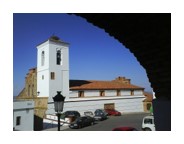Discover the charm of Extremadura
Puebla de Alcocer
The municipal district Puebla de Alcocer, located NE of the province of Badajoz in the region of Siberia Extremeña, is extensive, reaching 296.7km square.
Belonging to the Judicial Party of Herrera del Duque, it is situated on the side of a mountain range crowned by a medieval castle built in the 13th century. Its streets and terrain are irregular and steep, allowing the more adventurous to enter entertaining hiking trails. The municipality is included in the ZEPA zone (Special Protection Area for Birds), thus constituting a very interesting place for birding, or bird watching. In addition, in its surroundings there have been vestiges of both the Roman and Carthaginian times, which shows that the settlement was formalized centuries ago.
History
Among the most important remains found within the village, the best known is the “Lacimurga Constantia Iulia” site, which reached its greatest splendor in the second century BC. C. during the Roman era.
In the 13th century, during the reconquest, Puebla de Alcocer was an important population center belonging to the current province of Toledo and was declared a village in 1441.
In 1834 he established himself as the head of the Party, causing his population to increase to almost 2,200 inhabitants, almost twice as many as he has today.
With the Badajoz Plan of 1954, several swamps were built flooding the valleys of the Guadiana, Zújar and Guadalimar rivers, causing many young people to migrate to the new towns. As a consequence its population and its importance as an urban nucleus decreased, currently having a density of just over 1,200 inhabitants.
There are several historical figures of Puebla de Alcocer that can be highlighted: Don Gutiérrez de Sotomayor, Lord of the Castle; Fray Juan de la Puebla, Reformer of the Order of the Franciscans; Alonso Diego López de Zúñiga, to whom the work of Cervantes “El Quijote” is dedicated; Fray Fernando de Moragas, the second Marco Polo; and Don Antonio Hernández Gil, President of the Cortes.
Places to visit
Among its monuments, the 13th-century castle stands out from where the entire Serena Valley can be seen. It has a polygonal and irregular floor plan with two doors, one facing east and the other facing west. Of the original units currently there are only a few walls and a tower. Remodeled at the end of the XV, it was built with a single objective: to monitor and defend a large area that is below its skirts.
 Other monuments that are worth a visit are the Church of Santiago Apóstol of Romanesque-Mudejar style and that is the main church of the municipality, the convent of San Francisco and that of the visitation (currently under reconstruction).
Other monuments that are worth a visit are the Church of Santiago Apóstol of Romanesque-Mudejar style and that is the main church of the municipality, the convent of San Francisco and that of the visitation (currently under reconstruction).
Puebla de Alcocer also has two museums: the Ethnographic and the Gigante Extremeño, a museum in honor of a young man who lived in the town at the end of the 19th century and was 2.35m tall. Agustín Luengo Capilla, as it was called, has gone down in history as one of the tallest men in the world and its remains remain exposed in the National Museum of Anthropology of Madrid.
Routes
- Castle Route: 1.5 km
- Glue point: 3,5 Km
- Lares Fortress: 4,5 Km
